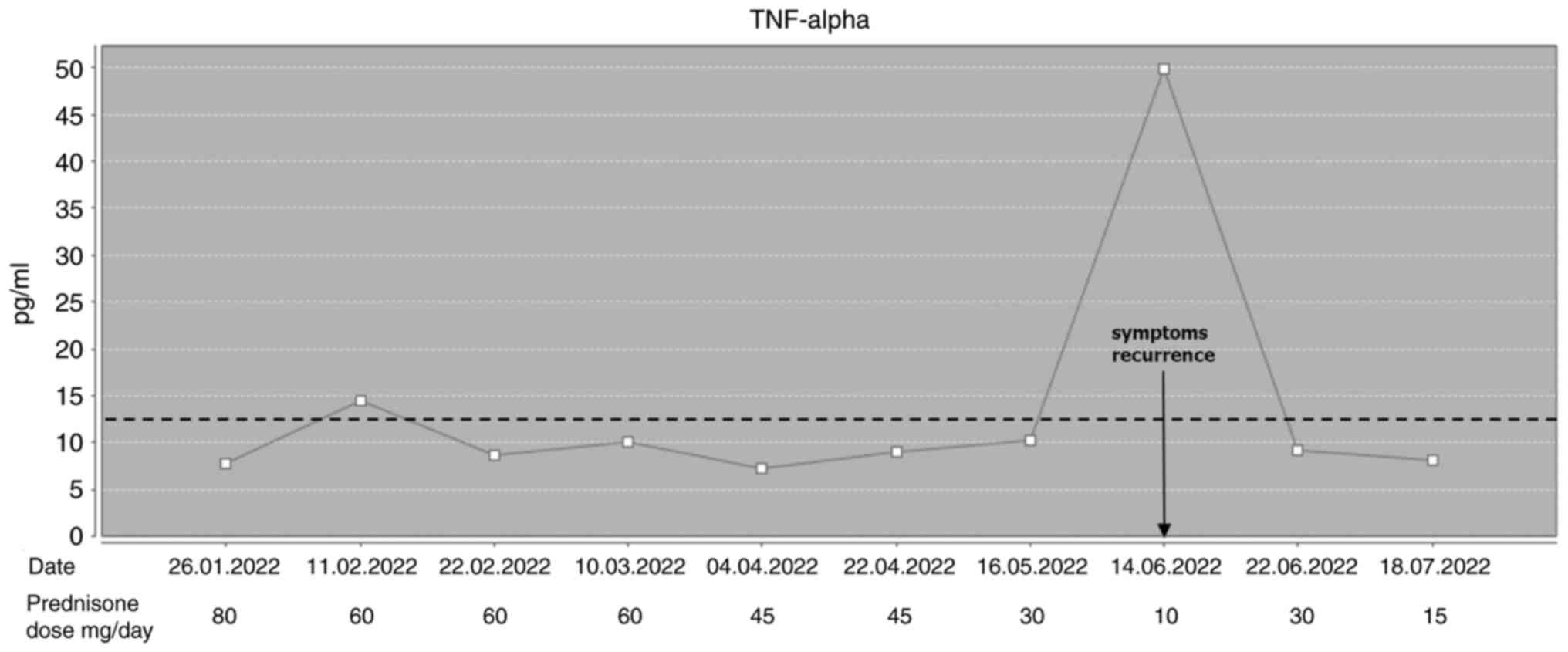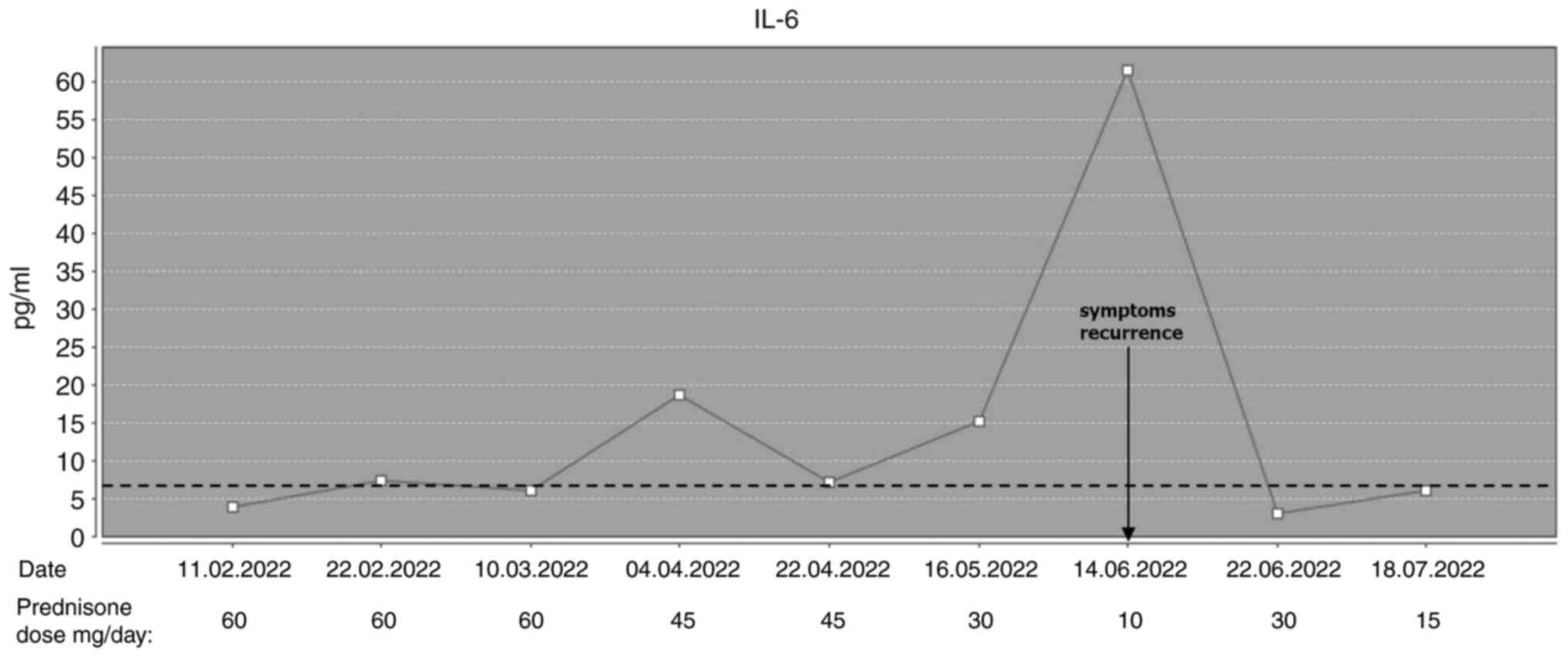|
1
|
Wesley SF, Haggiagi A, Thakur KT and De
Jager PL: Neurological immunotoxicity from cancer treatment. Int J
Mol Sci. 22(6716)2021.PubMed/NCBI View Article : Google Scholar
|
|
2
|
Ceschi A, Noseda R, Palin K and Verhamme
K: Immune checkpoint inhibitor-related cytokine release Syndrome:
Analysis of WHO global pharmacovigilance database. Front Pharmacol.
11(557)2020.PubMed/NCBI View Article : Google Scholar
|
|
3
|
Liu LL, Skribek M, Harmenberg U and
Gerling M: Systemic inflammatory syndromes as life-threatening side
effects of immune checkpoint inhibitors: Case report and systematic
review of the literature. J Immunother Cancer.
11(e005841)2023.PubMed/NCBI View Article : Google Scholar
|
|
4
|
Hamida O, Karlsson F, Lundqvist A, Gerling
M and Liu LL: Cytokine release syndrome after treatment with immune
checkpoint inhibitors: An observational cohort study of 2672
patients from Karolinska University Hospital in Sweden.
Oncoimmunology. 13(2372875)2024.PubMed/NCBI View Article : Google Scholar
|
|
5
|
Tay SH, Toh MMX, Thian YL, Vellayappan BA,
Fairhurst AM, Chan YH, Aminkeng F, Bharwani LD, Huang Y, Mak A and
Wong ASC: Cytokine release syndrome in cancer patients receiving
immune checkpoint inhibitors: A case series of 25 patients and
review of the literature. Front Immunol. 13(807050)2022.PubMed/NCBI View Article : Google Scholar
|
|
6
|
Zhang Y, Wen X, OuYang Y, Hu Y, Fang X,
Zhang J and Yuan Y: Severe cytokine release syndrome induced by
immune checkpoint inhibitors in cancer patients-A case report and
review of the literature. Heliyon. 10(e24380)2024.PubMed/NCBI View Article : Google Scholar
|
|
7
|
Tanaka T, Taoka M, Makimoto G, Ninomiya K,
Higo H, Fujii M, Ichihara E, Ohashi K, Hotta K, Tabata M and Maeda
Y: Severe cytokine release syndrome and immune effector
cell-associated neurotoxicity syndrome in a man receiving immune
checkpoint inhibitors for lung cancer: A case report. Intern Med.
63:1261–1267. 2024.PubMed/NCBI View Article : Google Scholar
|
|
8
|
Kennedy LB and Salama AKS: A review of
cancer immunotherapy toxicity. CA Cancer J Clin. 70:86–104.
2020.PubMed/NCBI View Article : Google Scholar
|
|
9
|
Haanen JBAG, Carbonnel F, Robert C, Kerr
KM, Peters S, Larkin J and Jordan K: ESMO Guidelines Committee.
Management of toxicities from immunotherapy: ESMO Clinical Practice
Guidelines for diagnosis, treatment and follow-up. Ann Oncol. 28
(suppl_4):iv119–iv142. 2017.PubMed/NCBI View Article : Google Scholar
|
|
10
|
Puzanov I, Diab A, Abdallah K, Bingham CO
III, Brogdon C, Dadu R, Hamad L, Kim S, Lacouture ME, LeBoeuf NR,
et al: Managing toxicities associated with immune checkpoint
inhibitors: Consensus recommendations from the Society for
Immunotherapy of Cancer (SITC) Toxicity Management Working Group. J
Immunother Cancer. 5(95)2017.PubMed/NCBI View Article : Google Scholar
|
|
11
|
Tvedt THA, Vo AK, Bruserud Ø and Reikvam
H: Cytokine release syndrome in the immunotherapy of hematological
malignancies: The biology behind and possible clinical
consequences. J Clin Med. 10(5190)2021.PubMed/NCBI View Article : Google Scholar
|
|
12
|
Wang J and Doran J: The many faces of
cytokine release syndrome-related coagulopathy. Clin Hematol Int.
3:3–12. 2021.PubMed/NCBI View Article : Google Scholar
|
|
13
|
Morris EC, Neelapu SS, Giavridis T and
Sadelain M: Cytokine release syndrome and associated neurotoxicity
in cancer immunotherapy. Nat Rev Immunol. 22:85–96. 2022.PubMed/NCBI View Article : Google Scholar
|
|
14
|
Velasco R, Villagrán M, Jové M, Simó M,
Vilariño N, Alemany M, Palmero R, Martínez-Villacampa MM, Nadal E
and Bruna J: Encephalitis induced by immune checkpoint inhibitors:
A systematic review. JAMA Neurol. 78:864–873. 2021.PubMed/NCBI View Article : Google Scholar
|
|
15
|
Siegler EL and Kenderian SS: Neurotoxicity
and cytokine release syndrome after chimeric antigen receptor T
cell therapy: Insights into mechanisms and novel therapies. Front
Immunol. 11(1973)2020.PubMed/NCBI View Article : Google Scholar
|
|
16
|
Rice J, Nagle S, Randall J and Hinson HE:
Chimeric antigen receptor T cell-related neurotoxicity: Mechanisms,
clinical presentation, and approach to treatment. Curr Treat
Options Neurol. 21(40)2019.PubMed/NCBI View Article : Google Scholar
|
|
17
|
Si S and Teachey DT: Spotlight on
tocilizumab in the treatment of CAR-T-Cell-induced cytokine release
syndrome: Clinical evidence to date. Ther Clin Risk Manag.
16:705–714. 2020.PubMed/NCBI View Article : Google Scholar
|
|
18
|
Ohira J, Kawamoto M, Sugino Y and Kohara
N: A case report of fulminant cytokine release syndrome complicated
by dermatomyositis after the combination therapy with immune
checkpoint inhibitors. Medicine (Baltimore).
99(e19741)2020.PubMed/NCBI View Article : Google Scholar
|
|
19
|
Das S and Johnson DB: Immune-related
adverse events and anti-tumor efficacy of immune checkpoint
inhibitors. J Immunother Cancer. 7(306)2019.PubMed/NCBI View Article : Google Scholar
|











